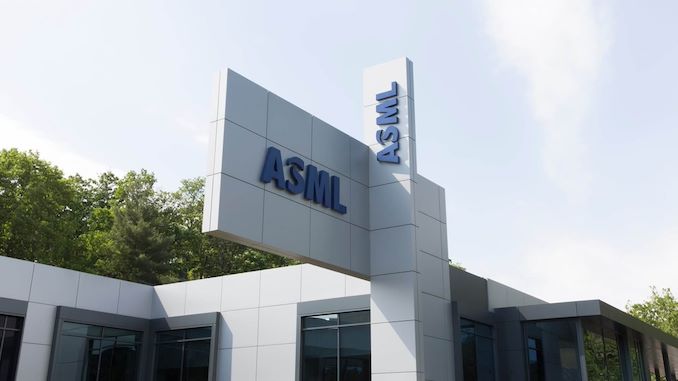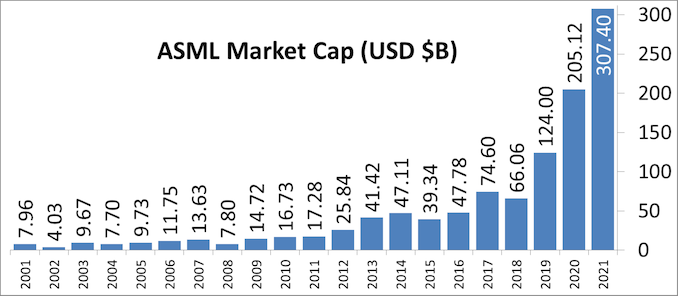Intel's Process Roadmap to 2025: with 4nm, 3nm, 20A and 18A?!
by Dr. Ian Cutress on July 26, 2021 5:00 PM ESTSidebar on Intel EUV
In all of these announcements, one thing to highlight is Intel mentioning its relationship with ASML, the sole company that manufactures the EUV machines powering production of leading edge semiconductor manufacturing.
ASML is a unique company in that it is the only one that can produce these machines, because the technology behind them is often tied up with its partners and research, but also because all the major silicon manufacturers are heavily invested in ASML. For any other company to compete against ASML would require building a separate network of expertise, a decade of innovation and design, and a lot of capital. None of the major silicon vendors want to disturb this balance and go off on their own, lest it shuts them out of the latest manufacturing technology, and no research fund sees competing against the embedded norm as a viable opportunity. This means that anyone wanting EUV specialist technology has to go to ASML.
In 2012, it was reported that Intel, Samsung, and TSMC all invested in ASML. This was, at the time, to jumpstart EUV development along with migrating from 300mm wafers to 450mm wafers. While we haven’t moved to 450mm wafers yet (and there are doubts we will any time in the next decade), EUV is now here. Intel’s 2012 investment of $2.1 billion gave them a 10% stake in ASML, with Intel stating that it would continue investing up to a 25% stack. Those stakes are now below the 5% reporting threshold, but all three of the major foundry customers are still big owners, especially as ASML’s market cap has risen from $24 Billion in 2012 to $268 Billion in 2021 (surpassing Intel).
As major investors but also ASML’s customers, the race has been on for these foundries to acquire enough EUV machines to meet demand. TSMC reported in August 2020 that it has 50% of all EUV machines manufactured at ASML for its leading edge processes. Intel is a little behind, especially as none of Intel’s products in the market yet use any EUV. EUV will only intercept Intel’s portfolio with its new Intel 4 process, where it will be used extensively, mostly on the BEOL. But Intel still has to order machines when they need them, especially as there are reports that ASML currently has backorders of 50 EUV machines. In 2021, ASML is expected to manufacture around 45-50 machines, and 50-60 in 2022. The exact number of machines Intel has right now, or has ordered from ASML, is unknown. It is expected that each one has a ~$150m price tag, and can take 4-6 months to install.
With all that being said, Intel’s discussion point today is that it will be the lead customer for ASML’s next generation EUV technology known as High-NA EUV. NA in this context relates to the ‘numerical aperture’ of the EUV machine, or to put simply, how wide you can make the EUV beam inside the machine before it hits the wafer. The wider the beam before you hit the wafer, the more intense it can be when it hits the wafer, which increases how accurately the lines are printed. Normally in lithography to get better printed lines, we move from single patterning to double patterning (or quad patterning) to get that effect, which decreases yield. The move to High-NA would mean that the ecosystem can stay on single patterning for longer, which some have quoted as allowing the industry to ‘stay aligned with Moore’s Law longer’.
| ASML's EUV Shipments | |||||||||||||||||||||
| 2015 | 2016 | 2017 | 2018 | 2019 | 2020 | 2021 | |||||||||||||||
| Actual | 2 | 4 | 10 | 3 | 4 | 5 | 6 | 4 | 7 | 7 | 8 | 4 | 7 | 14 | 8 | 7 | 9 | - | - | ||
| Target (Total) | - | - | - | 20 (18) | 30 (26) | 35 (33) | 45-50 | ||||||||||||||
| 2018 and beyond is split per quarter for actual shipped numbers Data taken from ASML's Financial Reports |
|||||||||||||||||||||
Current EUV systems are NA 0.33, while the new systems are NA 0.55. ASML’s latest update suggests that it expects customers to be using High-NA for production in 2025/2026, which means that Intel is likely going to be getting the first machine (ASML NXE:5000 we think) in mid-2024. Exactly how many High-NA machines ASML intends to produce in that time frame is unknown, as if they flood the market, having the first won’t be a big win. However if there is a slow High-NA ramp, it will be up to Intel to capitalize on its advantage.













326 Comments
View All Comments
DigitalFreak - Monday, July 26, 2021 - link
It is 20 amps. That's how many amps @ 110v you'll need in the near future to power just their processor.mode_13h - Monday, July 26, 2021 - link
Lol. Pretty much.Timoo - Tuesday, July 27, 2021 - link
Although 20A sounds reasonable for an Intel, these days /sboeush - Monday, July 26, 2021 - link
Instead of this meaningless "nm" node name stupidity, Intel should've just moved to a transistor-density-based node naming. For example, "Intel 100" for 100 million transistors per square mm. Then for same-node refinement (where density stays the same but transistor or circuit performance improves), they could've used a revision number - e.g. Intel 100 mk. 1, Intel 100 mk. 2, etc.That would've returned industry nomenclature back to reality, and also poked the eye of Intel's competitors who have been propagating this "nm" nonsense.
Alistair - Monday, July 26, 2021 - link
i think that would have been a better idea, just overturn the NM naming convention completely, now it feels like joining the fake clubboozed - Monday, July 26, 2021 - link
Nautical Miles?!Kamen Rider Blade - Monday, July 26, 2021 - link
I think Nautical Miles should really use the "NMi" abreviation.This would make it less confusing when somebody accidentally writes lower case "nmi" and not create confusion with between Nanometer & Nautical Mile.
Lord of the Bored - Tuesday, July 27, 2021 - link
I think if there's confusion between nanometers and nautical miles, something has gone very wrong with the conversation.It is like millivolts and megavolts. Yes, they are both spelled mv(case-insensitively), but if one is confused for the other there was a LOT of context missing.
(I wanted to use millimeter and megameter, but every time I use the latter I am met with confusion or scorn.)
mode_13h - Wednesday, July 28, 2021 - link
> every time I use the latter I am met with confusion or scorn.Same thing, when I try to casually drop kiloseconds or megaseconds into a conversation.
: )
Seriously, the people mainly using distances on the order of 10^6 m are astronomers or rocket scientists. And they're dealing with such a large range of distances that it makes more sense to just drop the SI prefix and use scientific notation.
Lord of the Bored - Thursday, July 29, 2021 - link
But megameter is such an awesome word!Kilosecond is weird because we don't use a base ten time system. Not even the threat of the guillotine could win that fight against traditional units.